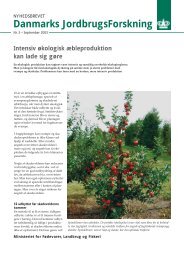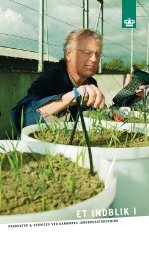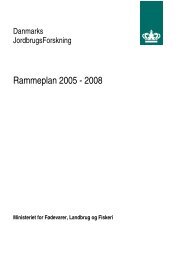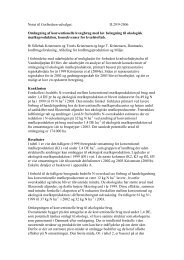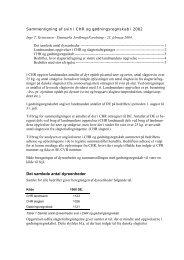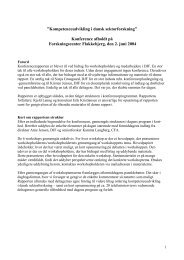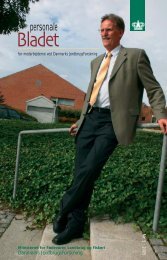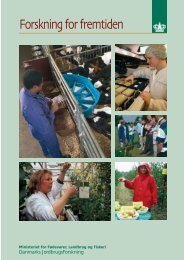Reproduction performances and conditions of group-housed non ...
Reproduction performances and conditions of group-housed non ...
Reproduction performances and conditions of group-housed non ...
You also want an ePaper? Increase the reach of your titles
YUMPU automatically turns print PDFs into web optimized ePapers that Google loves.
- Paper III -<br />
In herds practising <strong>group</strong> feeding in the pregnancy department, back fat at farrowing de-<br />
creased significantly with decreasing parity number. This was not the case in herds with<br />
individual feeding. Since the same pattern was seen already at weaning, this may partly be a<br />
result <strong>of</strong> the sows’ condition at weaning more than a result <strong>of</strong> the sows condition throughout<br />
the <strong>non</strong>-lactating period (qua the high correlations between the back fat measurements<br />
between different measurement day). However, as the interaction between system <strong>and</strong> parity<br />
<strong>group</strong> became more <strong>and</strong> more significant for every day <strong>of</strong> measurement, it indicates that<br />
high-parity sows are favoured in herds with <strong>group</strong> feeding to a much larger extent compared<br />
to herds with individual feeding. This is further supported by the higher increase in<br />
back fat gain from weaning to three weeks in pregnancy with increasing parity <strong>group</strong> seen<br />
in the <strong>group</strong> feeding systems. The effect <strong>of</strong> parity <strong>group</strong> on back fat gain from three weeks<br />
after mating to farrowing did not differ between feeding systems. However when including<br />
the interaction, although the <strong>non</strong>-significance (P=0.17) the same trend was seen (results not<br />
shown). In addition, the behavioural observations showed that sows older than third parity<br />
spend significant more time eating compared to first to third parity sows in the <strong>group</strong> feeding<br />
herds.<br />
As several studies have found a positive correlation between parity <strong>and</strong> rank (Arey & Edwards,<br />
1998), it seems that the low ranked sows had less access to feed compared to the<br />
older high ranked sows in <strong>group</strong> feeding systems. This is supported by results from a previously<br />
field study that indicated lower feed intake in low compared to high ranking sows, as<br />
indicated by less increase in chest girth (Olsson & Svendsen, 1997). Also several experimental<br />
studies have indicated lower feed intake in low compared to high ranking sows in<br />
<strong>group</strong> feeding systems, as indicated by lower weight gain (Brouns & Edwards, 1994; Ruis<br />
et al., 2002), less time spend at the central area <strong>of</strong> the pile <strong>of</strong> feed provided on the floor<br />
(Csermely & Wood-Gush, 1990) <strong>and</strong> less time spent at the trough (Andersen et al., 1999).<br />
The result <strong>of</strong> the back fat measurements implies that <strong>group</strong> fed sows in average are provided<br />
with a larger amount <strong>of</strong> feed compared to individual fed sows probably in an attempt<br />
to achieve that all sows, also the low ranked get adequate amount <strong>of</strong> feed during pregnancy.<br />
The results <strong>of</strong> this study indicate an overfeeding <strong>of</strong> sows older than third parity more than<br />
an underfeeding <strong>of</strong> the young sows when looking upon average data. However, in the herds<br />
with <strong>group</strong> feeding, six % <strong>of</strong> all sows had back fat depth less than 10 mm at farrowing. In<br />
addition, in the <strong>group</strong> feeding systems, 11 out <strong>of</strong> 256 sows ate less than 20 % <strong>of</strong> all observations<br />
during feeding <strong>and</strong> four sows did not eat at all three weeks after mating. In this<br />
study, all the sows in the <strong>group</strong> feeding herds were fed amounts <strong>of</strong> feed below their capacity<br />
for feed intake during pregnancy (Brouns et al., 1991). It is therefore presumable that<br />
the majority <strong>of</strong> sows were motivated to eat (Jensen et al., 2000) <strong>and</strong> that sows, which did<br />
not eat were displaced from the feed or ‘chose’ to stay away to avoid aggressions. Taken<br />
79




